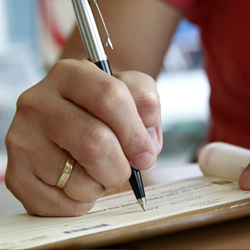September 2022
Many people forget about checks, opting to pay for purchases with a debit card instead. If you don’t use them often, you probably have a checkbook stashed in a drawer somewhere. But believe it or not, they still serve a vital purpose in modern money management. Here is a closer look at the basics of checks.
The basics of checks
Checks represent real money that you have in your checking account. They provide a record of what money is spent, where it was spent and what was deposited into your account. Plus, unlike cash, checks also have some built-in protections in case they get lost or stolen, such as stop payments that make them null and void.
Most places take checks as payment, often processing the check immediately to make sure you have the money in your account. So be careful to only write a check if you have the funds to cover it, or you most likely will get charged an overdraft fee or the payment could be declined all together.
Writing a check
There are five sections you must complete to successfully write a check — the date, who the check is going to or recipient’s name, the amount of the check in numerical form, the amount of the check written in words, and the signature line. The memo line located in the bottom left of the check can be left blank, or you can write what the check is for so you’ll remember when you’re balancing your checkbook later.
Numbers on a check
A check displays separate sequences of numbers on the bottom and the top. The first sequence of numbers on the bottom represents the bank’s routing transit number. This code identifies your bank, allowing the check to be directed to the right place for processing. Next to the routing transit number is your checking account number, so the bank knows which account the money should come from. Last, on top right of the check is the check number, often printed above the date field. This helps identify which check was used for what purpose, especially if the amounts are the same.
Depositing a check
When you receive a check, depositing that money into your account is simple. Flip over the check and sign your name as it appears on the front of the check in the designated endorsement section. For security reasons, we recommend waiting until you are at the bank or in the process of making a mobile deposit before signing. Otherwise, someone else could try to cash it before you realize it’s missing.
If you do a mobile deposit, just remember to check the mobile deposit box on the back and include “For Mobile Deposit Only” below your signature in the endorsement area. After that, Waukesha State Bank asks that you keep your check in a safe place for 14 days in case there are any questions and to make sure the funds are deposited correctly. Once that time is up and the check has cleared your account, you can shred the check to dispose of it safely. Learn about Mobile Deposit at Waukesha State Bank.
Tracking checks and balancing the account
The check register provides a simple way to track what is coming in and going out of your checking account. By recording the date, check number, amount, and the recipient, you have a record of payments and deposits, and can review your spending habits as well.
With the check register up to date, it’s also important that you balance your checkbook when you get your account statement. Doing this compares what you recorded in your check register – whether it’s a check, deposit, debit transaction, ACH, online transfer, etc. – against what the bank recorded in your account. You want to make sure both records match, are free from mathematical mistakes, and factor in interest, if any was earned.
Checks are still very important to understand. Knowing how to use them, when to use them, how to protect them and your account are all vital to managing your money well. If you ever have any questions about checks or your checking account, let our bankers know. We’re always here to help.
